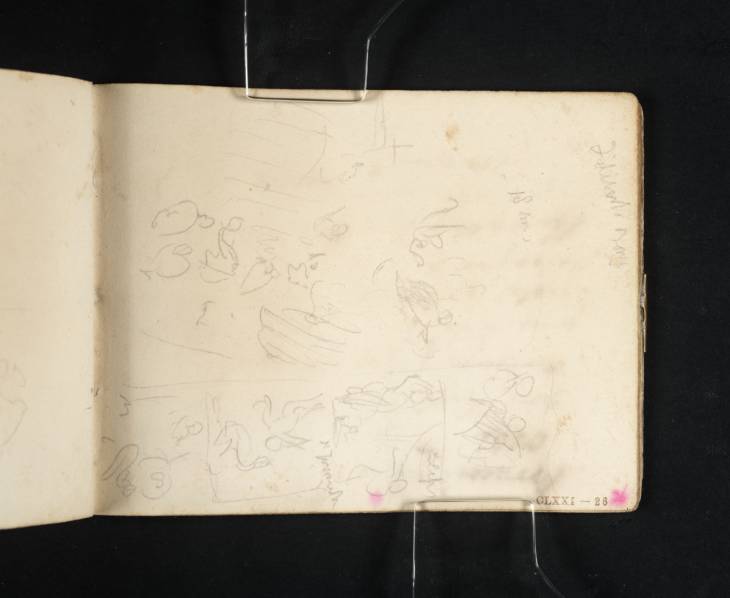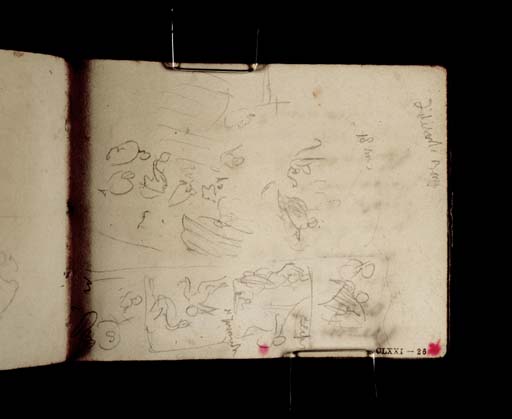Joseph Mallord William Turner Copies of Pictures by Tintoretto in the Scuola Grande di San Rocco, Venice 1819
Image 1 of 2
Joseph Mallord William Turner,
Copies of Pictures by Tintoretto in the Scuola Grande di San Rocco, Venice
1819
Joseph Mallord William Turner 1775–1851
Folio 26 Recto:
Copies of Pictures by Tintoretto in the Scuola Grande di San Rocco, Venice 1819
D13907
Turner Bequest CLXXI 26
Turner Bequest CLXXI 26
Pencil on white wove paper, 114 x 88 mm
Inscribed by the artist in pencil ‘Fili[...] Boria’ and ‘18 [?times]’ top left and ‘[
Inscribed by John Ruskin in red ink ‘26’ top right, ascending right-hand edge
Stamped in black ‘CLXXI 8’ ascending right-hand edge
Inscribed by John Ruskin in red ink ‘26’ top right, ascending right-hand edge
Stamped in black ‘CLXXI 8’ ascending right-hand edge
Accepted by the nation as part of the Turner Bequest 1856
Exhibition history
2003
Turner and Venice, Tate Britain, London, October 2003–January 2004, Kimbell Art Museum, Fort Worth, February–May 2004, Museo Correr, Venice, September 2004–January 2005, Fundació ”la Caixa”, Barcelona, March–June 2005 (75, reproduced fig.49).
References
1909
A.J. Finberg, A Complete Inventory of the Drawings of the Turner Bequest, London 1909, vol.I, p.498, as ‘Sketches of various pictures; a Crucifixion (? by Veronese), &c.’.
1971
Jerrold Ziff, ‘John Gage, “Color in Turner: Poetry and Truth” ’, Art Bulletin, vol.53, March 1971, pp.125–6.
1983
John Gage, Jerrold Ziff, Nicholas Alfrey and others, J.M.W. Turner, à l’occasion du cinquantième anniversaire du British Council, exhibition catalogue, Galeries nationales du Grand Palais, Paris 1983, p.30.
2003
Ian Warrell, David Laven, Jan Morris and others, Turner and Venice, exhibition catalogue, Tate Britain, London 2003, no.75, pp.17, 59, 61, 63, reproduced fig.49, as ‘Copies of “The Crucifixion” and other pictures by Tintoretto in the Scuola Grande di San Rocco’.
During his 1819 stay in Venice, Turner made a particular study of the famous cycle of paintings by Tintoretto (1518–94) in the Scuola Grande di San Rocco. Ian Warrell has identified the sketches on this page as copies from the ceiling of the Upper Floor. The subjects are, from top left to bottom right, as follows:
a.
The largest sketch on the left-hand side of the page represents The Brazen Serpent circa 1575–6.1
b.
The details of the study in the top right-hand corner are extremely schematic. Warrell has tentatively suggested that they may depict Moses Drawing Water from the Rock or Jonah Leaves the Whale’s Belly circa 1577.2
c.
Second from top right is The Miracle of Manna circa 1577.3 Turner has annotated the sketch ‘[?Light]’ and ‘St Jeremiah’. The latter refers to the close proximity on the ceiling of another panel, The Vision of Jeremiah by Giuseppe Angeli (circa 1712–98).
d.
Third from top right is Elijah Fed by the Angel circa 1577/8.4
e.
The sketch in the bottom right-hand corner is currently unidentified, although it almost certainly also represents a subject from the same ceiling.
The largest sketch on the left-hand side of the page represents The Brazen Serpent circa 1575–6.1
b.
The details of the study in the top right-hand corner are extremely schematic. Warrell has tentatively suggested that they may depict Moses Drawing Water from the Rock or Jonah Leaves the Whale’s Belly circa 1577.2
c.
Second from top right is The Miracle of Manna circa 1577.3 Turner has annotated the sketch ‘[?Light]’ and ‘St Jeremiah’. The latter refers to the close proximity on the ceiling of another panel, The Vision of Jeremiah by Giuseppe Angeli (circa 1712–98).
d.
Third from top right is Elijah Fed by the Angel circa 1577/8.4
e.
The sketch in the bottom right-hand corner is currently unidentified, although it almost certainly also represents a subject from the same ceiling.
Turner was greatly impressed by Tintoretto’s use of colour and dramatic chiaroscuro, later elevating him above all other artists he had seen during his travels in Italy.5 He seems to have revisited the paintings of the Scuola Grande again in 1840, and Warrell has linked his study of Tintoretto’s series to the famous pair of late canvases based upon Goethe’s colour theories, Shade and Darkness – The Evening of the Deluge and Light and Colour (Goethe’s Theory) – The Morning after the Deluge – Moses writing the Book of the Genesis exhibited 1843 (both Tate, N00531 and N00532).6 The figure of the Moses and the coiled snake at the centre of Light and Colour, as well as the vertiginous sweep of figures within the composition, strongly recalls Tintoretto’s painting of a related Biblical subject, The Brazen Serpent, recorded on this sketchbook sheet.7
Further sketches from the Scuola Grande and the Chiesa di San Rocco can be seen on folios 23 verso, 24 verso, 25 verso, 26 verso–27, 29 verso–30 verso (D13902, D13904, D13906, D13908–D13909, D13914–D13916).
Nicola Moorby
March 2010
How to cite
Nicola Moorby, ‘Copies of Pictures by Tintoretto in the Scuola Grande di San Rocco, Venice 1819 by Joseph Mallord William Turner’, catalogue entry, March 2010, in David Blayney Brown (ed.), J.M.W. Turner: Sketchbooks, Drawings and Watercolours, Tate Research Publication, December 2012, https://www


